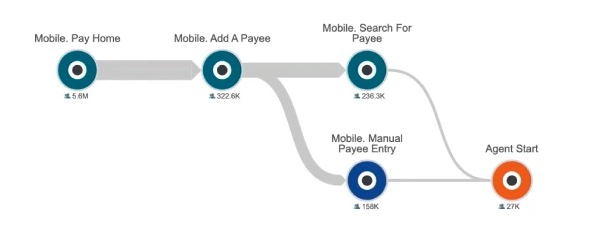Your Genesys Blog Subscription has been confirmed!
Please add genesys@email.genesys.com to your safe sender list to ensure you receive the weekly blog notifications.
Subscribe to our free newsletter and get blog updates in your inbox
Don't Show This Again.

Companies often are organized in such a way that they create silos. Silos in data, operations, management, vision, and ultimately, performance. The answer to the question, “How are we doing?” is limited to the perspective of an individual person, team or organization.
And in business, people do need to know how they’re doing when it comes to fulfilling their responsibility — their promise to the company. But often it isn’t easy to see how they’re doing through the lens of the customer.
From a customer’s perspective, there’s one company and one truth — and that’s their experience.
Various organizations play a role in the overall customer experience. The journey often begins with the marketing organization reaching for the first customer interaction – building brand awareness.
As they show interest and engage, the sales organization assists and nurtures them to ensure they know about the company’s products and services. After they’ve made the decision to purchase, the fulfillment organization delivers on the promise. And after the customer is established, the service organization keeps them informed and assists them when they need help.
Customers don’t know or care that there are different organizations and “service owners” behind the scenes as they navigate a company.
Any disconnect that causes them to put forth additional effort — to identify themselves, to tell their story again — drives frustration and dissatisfaction. Customers expect interactions where they feel known, heard and understood. They want a personalized experience where the company is guiding them to the right path and the right resources.
In addition to impacts to Net Promoter Scores and customer satisfaction rates, high-effort experiences are more costly to companies. Research has shown that a low-effort interaction costs 37% less than a high-effort interaction. Low-effort experiences reduce costs by decreasing up to 40% of repeat calls, 50% of escalations and 54% of channel switching.
And, according to a Harvard Business Review study, in association with Genesys, 81% of participating organizations believe that being able to measure CX along key points of the customer journey is important to their business strategy.
With customer effort being a significant driver for improved customer satisfaction, brand loyalty and cost, you might wonder where the points of friction are in your customer experience.
I confess, I’ve been a data geek for many years. And now with the power of artificial intelligence (AI) to help us churn through seas of customer data to surface insights, I tremble with excitement at the possibilities!
Recently, I’ve been sharing journey management output with business leaders. And I find that I’m not alone.
In a recent meeting, the team was sharing insights on customer behavior, points of friction and failure along customer journeys. They also looked at the impact of guiding more customers down the path to success — in real business revenue and cost savings.
The excitement in the room was palpable. Eyes were wide; minds were spinning. Voices were saying, “Wow, we’ve never seen this before!” and “This is incredible to see!”
Then they quickly shifted to “Could we also look at …?” and “Can we drill down into …?” These customer experience platform tools don’t only provide answers and real-time insights, they also inspire the next generation of questions.
With experience orchestration, you know where to start and where you could make the biggest improvements in your digital customer experience strategy.
Journey management provides you with the map to continuous improvement. By connecting with disparate data sources from across your digital touchpoints and multiple channels, journey management platforms unify data.
AI is used to stitch together identities from across customer activity to create an adaptive customer profile that’s continually learning. With a stitched identity, events that occur across channels can be captured, tracked and woven into journeys. Across website activity, social media posts, mobile apps, phone IVR systems, contact center agents, point-of-sales systems, service technician visits, ATMs — even IoT devices and telemetry — you’re capturing events.
This omnichannel experience is compiled into journeys. And users are presented with visualizations that show each step, each path and variation from Point A to Point Q in your experiences.
Find out how AI-Powered Experience Orchestration can help your business improve customer satisfaction, retention and loyalty.

Order of magnitude of the volume of users along each path segment is visualized in the thickness of the line to help you quickly understand whether a point of failure is a trickle or a raging river. Adding to the value of this picture is the ability to double-click into the common attributes of the users who are experiencing this friction or failure. Then you can quickly identify an impacted area. Examples might be demographic, geographic or application — to target for action and resolution.
While this can feel like a large effort that would need to involve multiple organizations and stakeholders across the company, it doesn’t have to be. Organizations are discovering opportunity and value in simple use cases, such as evaluating their IVR system to gain understanding into existing self-service application success rates.
They can also look at new customer intent that could benefit from application development. Or they’re looking at digital dropout from web or mobile applications to the contact center.
You can start small and grow from there. But once you share the insights you’re generating on your portion of the journey, your colleagues will soon want to find ways to join you. And that’s a good thing for customers and for the company.
Companies that are taking a design thinking approach, and looking at journeys holistically, are outperforming their competitors in all key metrics. Customer feedback shows they’re delighted with the seamless, low-effort experiences.
And these orchestrated experiences prove that the company knows who they are and what they’ve been through on their journeys; predicts their needs; and guides them to the right path. And when they connect with human representatives, those agents have all the context to pick up the path where the customer left off.
They have the skills and knowledge to satisfy customer needs and fill them with confidence. These are the adaptive customer experiences that drive brand loyalty and promoters.
I’ve had people say to me, “Charlie, I can’t afford to provide the kinds of experience that you’re describing.” I say, you can’t afford not to.
According to “The State of Customer Experience” report from Genesys, 77% of consumers will switch brands after five or fewer negative interactions with a brand’s customer service. And this doesn’t just apply to the consumer experience.
Research from McKinsey & Company states that better customer experience in B2B relationships is increasingly critical for growth. B2B leaders stated that lack of speed with supplier interactions was their No. 1 pain point, mentioned twice as much as price. The same principles apply.
The journey and experience are the one truth that customers have. Maybe we, as business leaders, have one truth, too — the experiences we provide to customers and employees.
Customer journey management is a first step to gain visibility and understanding into what’s working and what’s not. From there, we can use these insights as the map to create the next generation of customer satisfaction – AI-Powered Experience Orchestration.
Read the “Practical guide to mastering journey management” to get a phased approach for implementing journey management and tips on how to reduce time to value. And you’ll see how leading businesses are succeeding with customer journey management.
Subscribe to our free newsletter and get blog updates in your inbox.
Related capabilities: